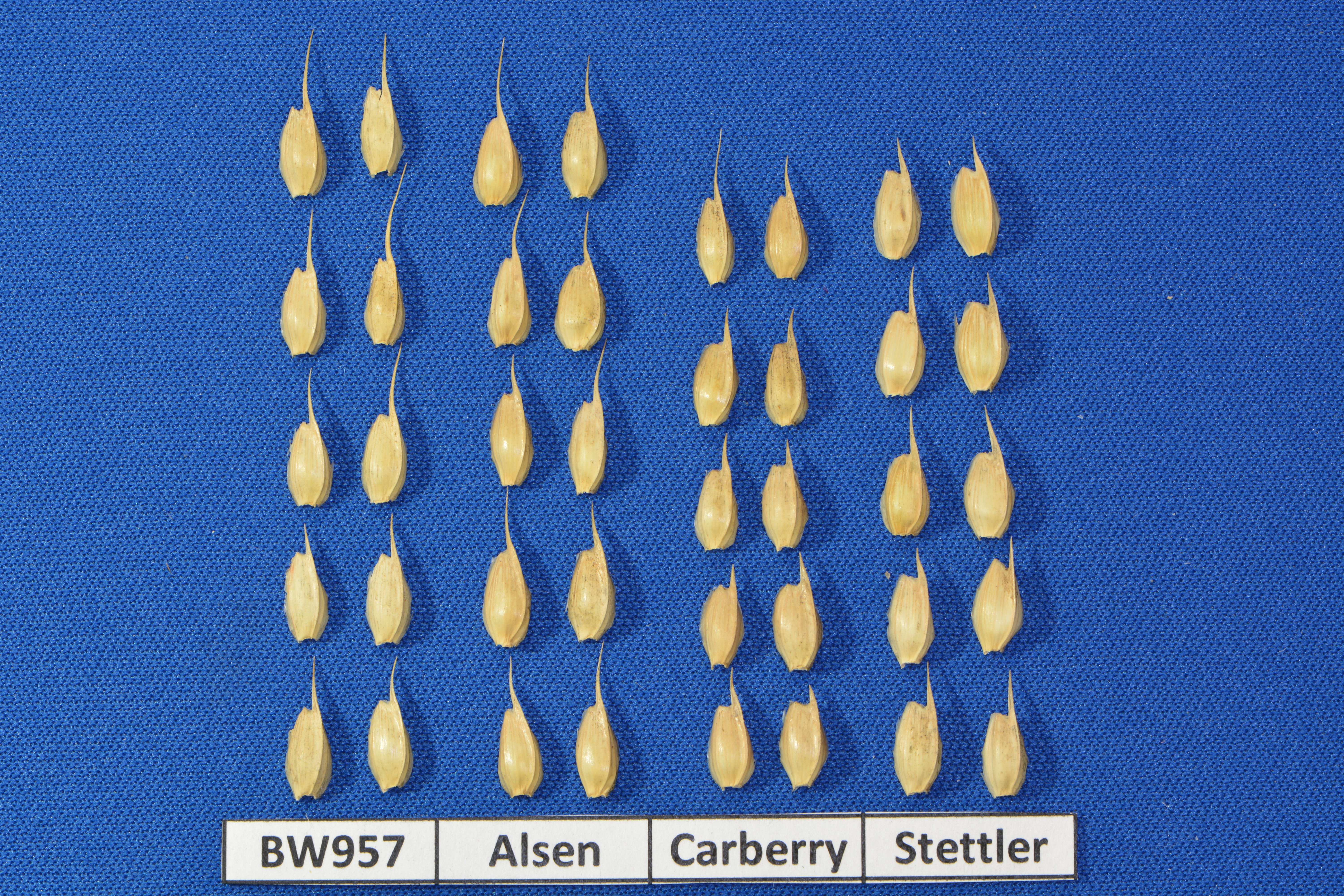AAC W1876
| Denomination: | 'AAC W1876' |
|---|---|
| Previously Proposed Denomination: | 'BW957' |
| Botanical Name: | Triticum aestivum |
| Applicant/Holder: |
Agriculture & Agri-Food Canada, Swift Current Research and Development Centre 1 Airport Road P.O. Box 1030 Swift Current, Saskatchewan S9H 3X2 Canada |
| Breeder: |
Richard Cuthbert, Agriculture & Agri-Food Canada, Swift Current, Saskatchewan |
| Agent in Canada: |
Agriculture & Agri-Food Canada Office of Intellectual Property and Commercialization c/o Shannon Whyte 107 Science Place Saskatoon, Saskatchewan S7N 0X2 Canada Tel: (204) 999-9887 |
| Application Date: | 2014-05-02 |
| Application Number: | 14-8305 |
| Grant of Rights Date: | 2016-05-16 |
| Certificate Number: | 5259 |
| Date rights surrendered: | 2022-05-16 |
Variety Description
Varieties used for comparison: 'Alsen', 'Carberry' and 'Stettler'
Summary: The plants of 'AAC W1876'' are shorter than those of 'Stettler'. The frequency of plants with recurved flag leaves is high for 'AAC W1876' whereas it is weak for 'Stettler'. The flag leaves of 'AAC W1876' are longer than those of 'Stettler' and shorter than those of 'Alsen'. 'AAC W1876' heads earlier than 'Stettler'. The spike of 'AAC W1876' is longer than that of 'Carberry'. At maturity, the spike of 'AAC W1876' has white awns with a nodding attitude whereas the reference varieties have light brown awns with an erect attitude. The culm of 'AAC W1876' is curved whereas it is straight for 'Alsen' and 'Stettler'.
Description:
PLANT: hard red spring wheat, semi-erect growth habit at the 5 to 9 tiller stage, high frequency of plants with recurved flag leaves, heads emerge and mature mid-season
SEEDLING (4-leaf stage): medium to strong intensity of anthocyanin colouration of the coleoptile, glabrous sheath and blade of the lower leaves
FLAG LEAF: absent or very weak intensity of anthocyanin colouration of the auricles, weak glaucosity of the sheath and lower side of leaf blade, glabrous blade and sheath
CULM: absent or very sparse density of hairiness of uppermost node, strong glaucosity, curved neck
SPIKE: strong glaucosity, tapering shape, medium density, yellow at maturity, nodding attitude at maturity, absent or very sparse hairiness of convex surface of apical rachis segment
AWNS: shorter than length of spike, white at maturity
LOWER GLUME SHOULDER: medium width, elevated to strongly elevated with second point present
LOWER GLUME: medium to long, medium width, glabrous
LOWER GLUME BEAK: medium to long, straight to slightly curved
STRAW: thin in cross section, no anthocyanin colouration at maturity
KERNEL: dark red
BREAD MAKING QUALITY: good
DISEASE REACTIONS: resistant to Leaf rust (Puccinia triticina); moderately resistant to Stem rust (Puccinia graminis f. sp. tritici) and Loose smut (Ustilago tritici); and moderately susceptible to Common bunt (Tilletia laevis, Tilletia tritici) and Fusarium head blight (Fusarium graminearum, Fusarium sp.)
Origin & Breeding History: 'AAC W1876' (tested as 'BW957' and 'B0418-JB41A') was selected from the cross 'Prodigy' / '5602HR' / / 'Alsen' made in 2004 at the Semiarid Prairie Agricultural Research Centre, Swift Current, Saskatchewan. The F1 seeds were increased in controlled environmental conditions at Swift Current. The F2 seeds were inoculated with common bunt and planted in a rust epiphytotic field nursery near Swift Current and individual plants were selected for disease resistances, semi-dwarf stature, straw strength and maturity. Seeds of individual spikes of the F3 and F5 were grown out near Lincoln and Irwell, New Zealand and selections were made for plant height, relative maturity, shattering and straw strength. Seed of the F4 to F8 generations was grown in various locations throughout Saskatchewan and Manitoba where they were assessed for agronomic performance, disease resistance and kernel characteristics. Through this breeding process, one line, 'B0418-JB41A', was identified as meeting all selection criteria at each generation. In 2009, 'B0418-JB41A' was tested in the Western Bread Wheat A_3 test and in the Western Bread Wheat B test in 2010. From 2011 to 2012, 'B0418-JB41A' was tested as 'BW957' in the Western Bread Wheat Cooperative tests and was entered in a Private Wheat Registration Trial in 2013.
Tests & Trials: The comparative trials for 'AAC W1876' were conducted at the Semiarid Prairie Agricultural Research Centre, Swift Current, Saskatchewan in 2013 and 2014. Plots consisted of 4 rows, each 5 metres long with an inter-row spacing of 23 cm with 4 replications per variety arranged in an RCB design. There were 40 leaf and 20 spike measurements. Plant height measurements were recorded as an average in each replicated plot. Means are based on a two year average. Mean differences are significant at the 5% probability level based on LSD values.
Comparison tables for 'AAC W1876' with reference varieties 'Alsen', 'Carberry' and 'Stettler'
Flag leaf length (cm)
| 'AAC W1876' | 'Alsen' | 'Carberry' | 'Stettler' | |
|---|---|---|---|---|
| mean (LSD=1.5) | 26.7 | 30.3 | 25.4 | 22.4 |
| std. deviation | 2.5 | 2.4 | 2.2 | 1.8 |
Days to heading
| 'AAC W1876' | 'Alsen' | 'Carberry' | 'Stettler' | |
|---|---|---|---|---|
| mean | 57.3 | 57.3 | 56.9 | 59.4 |
Plant height (cm) (including awns)
| 'AAC W1876' | 'Alsen' | 'Carberry' | 'Stettler' | |
|---|---|---|---|---|
| mean (LSD=3.4) | 97.5 | 95.6 | 95.7 | 103.0 |
| std. deviation | 4.5 | 4.1 | 3.1 | 5.2 |
Spike length (cm) (excluding awns)
| 'AAC W1876' | 'Alsen' | 'Carberry' | 'Stettler' | |
|---|---|---|---|---|
| mean (LSD=0.5) | 9.1 | 9.2 | 8.4 | 8.6 |
| std. deviation | 0.4 | 0.4 | 0.4 | 0.4 |
Click on image for larger view

Wheat: 'AAC W1876' (left) with reference varieties, 'Alsen' (centre left), 'Carberry' (centre right) and 'Stettler' (right)
- Date modified: